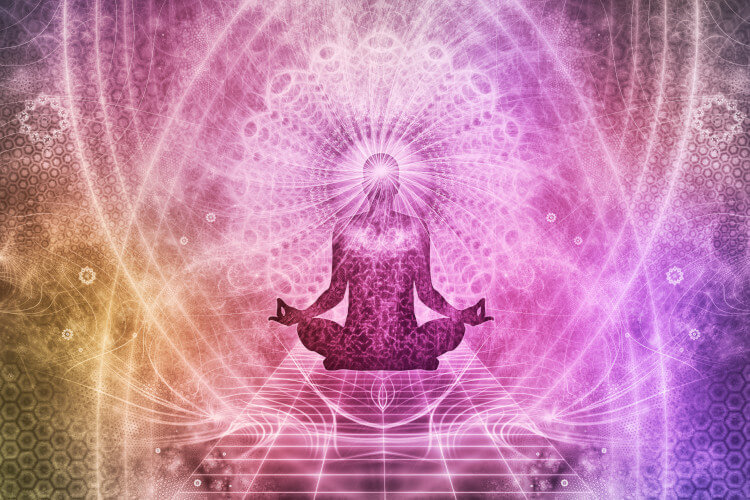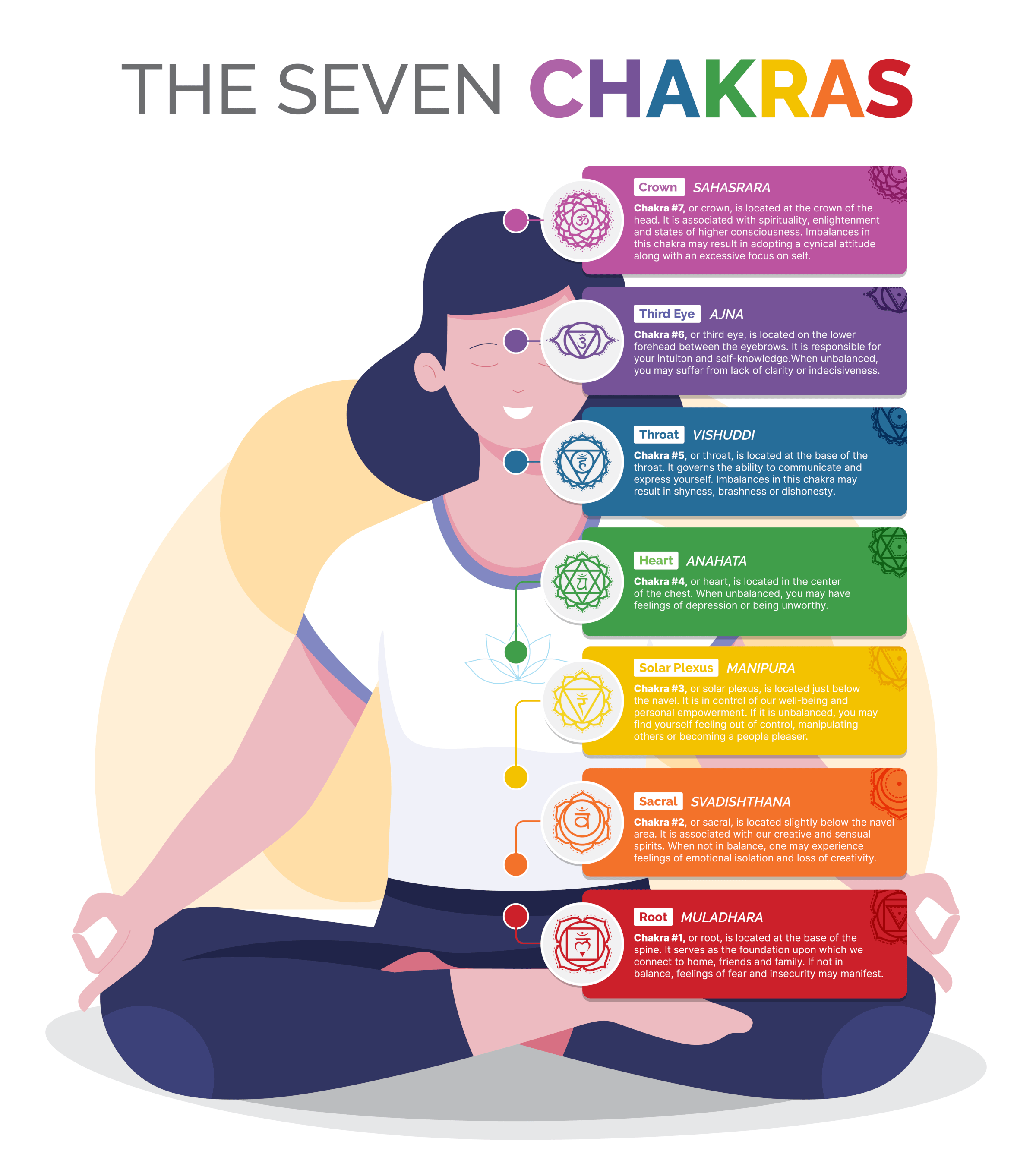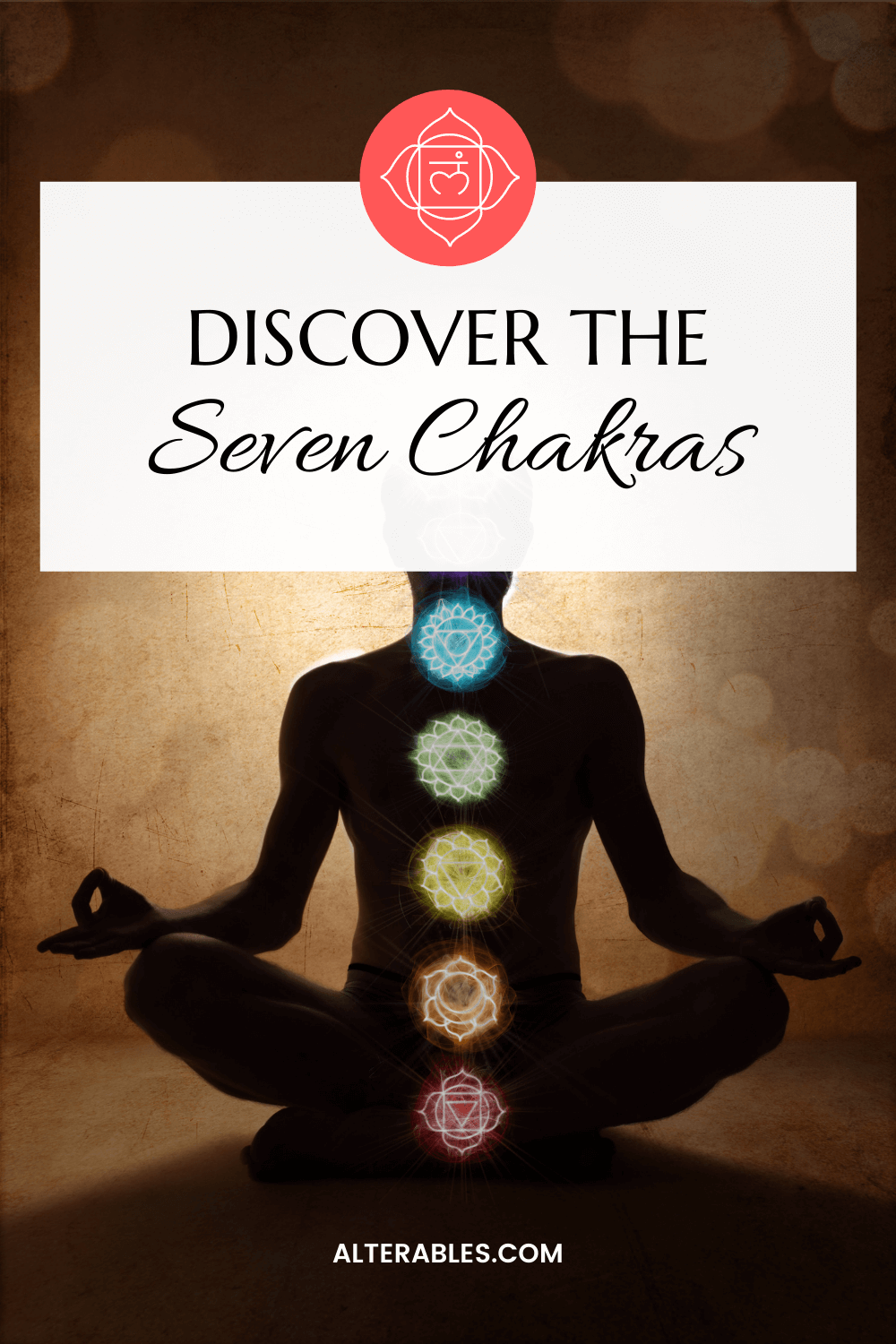
In the East, chakras are a core part of yoga and Vedanta philosophy. In Sanskrit, chakra means “wheel” or “circle.”
Seven chakras in the human body deal with different mental and physical health aspects.
The chakra system is divided into three main areas: physical, mental, and spiritual. Chakras also represent levels of consciousness.
Chart of the Seven Chakras
The attached chakra chart provides a quick reference for each charka’s location and attributes.

Below is a list of the chakra system and what they deal with:
Root Chakra – Muladhara
The color red represents the root chakra, and its symbol is a square. This chakra relates to the base of the spine. It controls our sense of security, safety, home, family, and feeling grounded.
When it’s blocked, you may experience fear and anxiety, and when it’s unbalanced, you may experience insecurity and restlessness.
When this chakra is balanced, you feel comfortable in your environment and can manage stress. You feel safe, supported, and well-grounded.
When the root chakra becomes unbalanced, it can lead to feelings of worry and stress. For example, you may become anxious about money or debts. You might feel the need to gamble.
You may become insecure and feel like there is danger lurking in the shadows.
Keeping your root chakra in balance helps you find and live out your passions and be stronger and more confident than ever.
Sacral Chakra – Svadhisthana
The sacral chakra is orange, and its shape is a circular disk. The chakra is located below the belly button and above the pubic area.
It deals with issues of self-worth and creativity, and it has a deep connection with glands such as the ovaries and testes. However, the chakra may be blocked by guilt, shame, apathy, or fear.
When blocked chakras are not working correctly, the chakras above and below the blockage begin to fill with energy, causing chakra burnout. The chakra may also be blocked by grief.
The chakra symbolizes the lotus flower, which has its roots in the mud, but blooms above the water to reach the sun. At the base of chakras are three small lines that represent the past, present, and future.
When things come together in mindfulness to clear chakras, the chakras can begin absorbing universal energy.
Solar Plexus Chakra – Manipura
The color of the solar plexus chakra is yellow, and its shape is circular.
The solar plexus chakra is located above and behind the stomach and below the rib cage. It is related to our sense of self, confidence, and personal power or lacking these – a lack of self-esteem.
It is also important to note that this chakra controls one’s attitude, self-esteem, and creativity.
It controls creativity, destructive jealousy, and anger (especially those who can see the inside without knowledge).
This chakra also deals with self-acceptance (or lack thereof) and issues of independence. A healthy solar plexus means one has the confidence to make decisions independently. At the same time, someone lacking in this aspect may need group consensus before making any critical choices.
Heart Chakra – Anahata
The color of the heart chakra is green, and its shape is spiral.
The heart chakra is located in the center of the chest between the shoulder blades. It has to do with how you give and receive love. People who have a strong heart chakra are considered loving, giving, compassionate, and forgiving.
People who lack a well-developed heart chakra may be selfish or carry anger from the past.
Suppose you are closed off emotionally and carry anger or hate. In that case, you need to start with your heart chakra to open up and have a healthy relationship with the world.
If you work on your heart chakra, you will find yourself more patient and understanding others’ faults. In addition, people who have a strong heart chakra are dedicated parents and good friends.
Throat Chakra – Vishuddha
The throat chakra is blue, and its shape is a crescent moon.
It is located by the throat, just as its name suggests. It is related to communication and expression on both a physical and spiritual level, affecting the thyroid and parathyroid glands.
When this chakra is in balance, you can communicate authentically and fearlessly and are open to hearing the words of others. It also relates to creativity in that they have to have a way to express themselves for them to flourish.
If your throat chakra is unbalanced, you will find yourself with an inability to communicate. You may find yourself holding in your feelings, unable to say how you feel.
This inability can lead to unhealthy relationships or even physical symptoms. You might also have difficulty hearing or expressing yourself in creative ways, including speaking, singing, writing, and painting.
If you work on your throat chakra, it will help you to open up and speak with confidence. You can do this by practicing exercises for the throat area or by chanting mantras to remind you of the power of your voice.
Third Eye Chakra – Ajna
The third eye chakra color is indigo, and its shape is the two-petaled lotus.
It is located in the middle of the forehead between the eyebrows. The third eye chakra is often associated with intuition and insight. Stimulating this chakra brings insight and awakening of the mind.
It can lead to a higher state of consciousness where we see not only intellectually but also intuitively.
This vision allows us to reach beyond the boundaries of our limited self.
When the third eye chakra is blocked, there are typically feelings of worry and anxiety. Those with a closed third eye chakra are generally unable to focus on anything, have trouble focusing on tasks or find everything so distressing that it’s challenging to cope with.
When your third eye chakra is open, your creativity flows more freely as well as your self-expression.
Crown Chakra – Sahasrara
The crown chakra color is violet, and its shape is the thousand-petaled lotus.
The crown chakra is located at the top of the head – above all other chakras. This chakra is associated with wisdom and higher consciousness. It is the gateway to our spirituality, pure awareness, higher thinking, and a sense of enlightenment.
When this chakra is open, individuals will have a strong sense of self and feel confident in their judgment. In addition, they will have a strong sense of inner vision and will be able to connect easily to their intuition.
When this chakra is closed, it can result in feelings of disconnection from others. An individual may feel very stressed or depressed by change, even small changes that are inevitable in life. They might have great difficulty making decisions because they cannot see how they might pan out.
It is interesting to note that some people who are well balanced in this chakra may be sensitive to psychic phenomena.
Summary
The seven chakras are essential to our overall health. Each one of them is associated with a specific function within the body. Thus, they are directly related to different parts of our spiritual and physical bodies.
Each one of these seven chakras must be balanced. A person with an unbalanced chakra would be susceptible to physical, mental, and spiritual problems.
Suppose one chakra is overactive and the others aren’t doing their share. In that case, there can be physical problems with the organs that are governed by that specific chakra.
—
Share this Post on Pinterest



